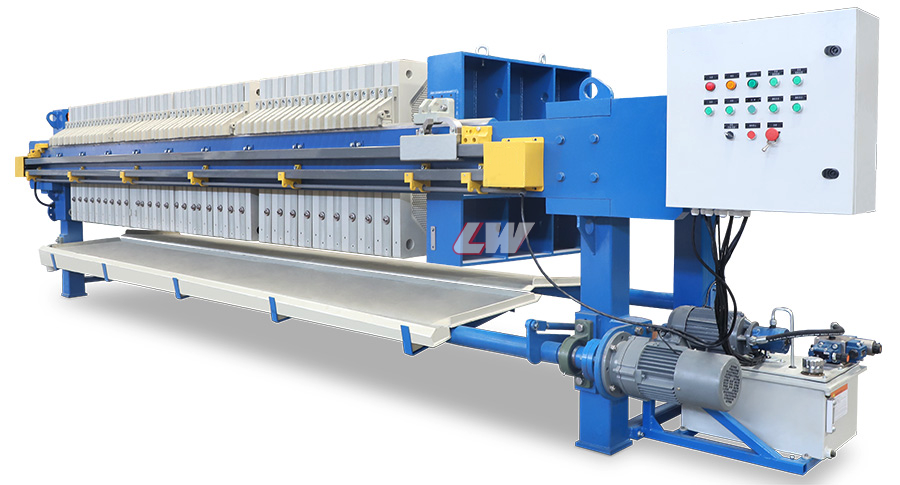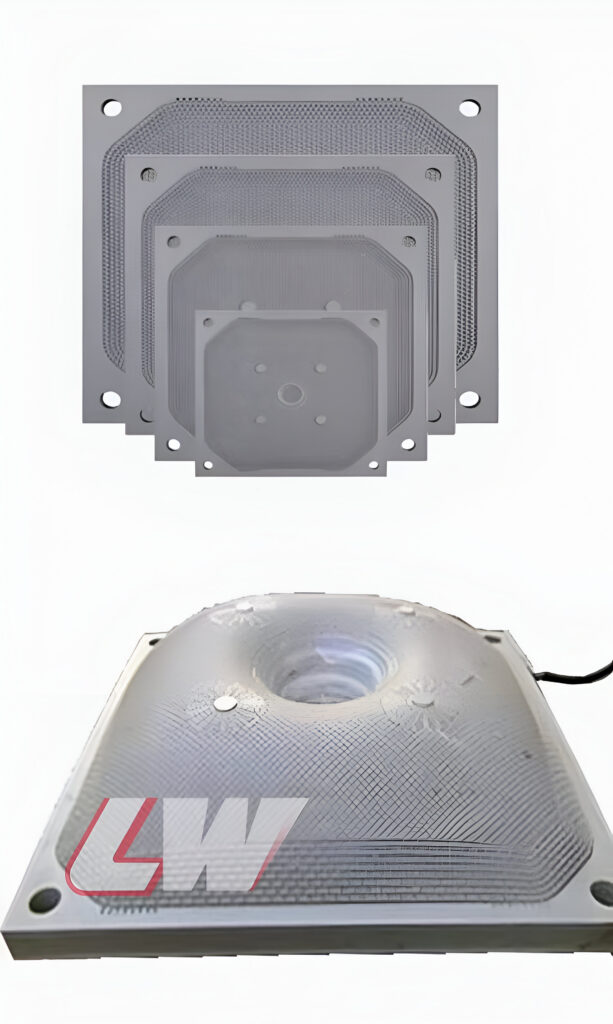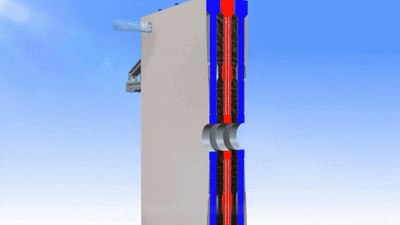Membrane Filter Press Equipment for You

How Our Membrane Filter Press Work for Your Project
Double-pressure dewatering filter press combines traditional pressure filtration with membrane squeezing technology. By introducing compressed air or water into the membrane cavity, the expanded membrane applies additional pressure to the filter cake, effectively squeezing out more liquid and substantially reducing the cake’s moisture content.
Membrane filter press specialized filtration systems combine traditional filter press mechanics with advanced membrane technology to achieve superior results in producing drier filter cakes while maintaining high throughput rates.
After initial filtration, these membranes inflate to apply additional mechanical pressure directly to the filter cake, squeezing out residual liquid that conventional filter presses cannot remove.
By combining conventional filtration principles with innovative membrane squeezing capabilities, these systems achieve superior dewatering results across numerous industries. The investment in membrane technology pays dividends through drier cakes, faster cycles, reduced disposal costs, and improved product recovery, making membrane filter presses the preferred choice for demanding solid-liquid separation applications.
Key Features & Advantages of Membrane Filter Press
✅Superior Moisture Reduction
- Achieves 20-50% drier cakes than conventional filter presses
- Reduces final moisture content by an additional 5-15% over standard recessed plate designs
- Creates stackable, non-sticky filter cakes ideal for handling and transport
✅Enhanced Processing Efficiency
- Shorter cycle times through more effective dewatering
- Reduced energy consumption compared to thermal drying
- Higher throughput rates in the same equipment footprint
✅Versatile Configuration Options
- Available in sizes from small lab units to industrial-scale installations
- Various plate dimensions and configurations for different applications
- Multiple membrane material options for chemical compatibility
✅Automation Capabilities
- Fully automated operation from feed to cake discharge
- Remote monitoring and control capabilities
- Data logging for process optimization and quality control
- Self-diagnostic systems for maintenance alerts

Membrane Filter Press Technical Specifications
| Parameter | Specification |
|---|---|
| Filtration Area | 10 m² to 500 m² |
| Plate Size | 500 mm x 500 mm to 2000 mm x 2000 mm |
| Operating Pressure | Up to 16 bar (232 psi) |
| Plate Material | Polypropylene, Stainless Steel, or Composite |
| Frame Material | Carbon Steel or Stainless Steel |
| Number of Plates | 20 to 200 plates |
| Cake Thickness | 20 mm to 50 mm |
| Feed Pump Pressure | 6 bar to 16 bar |
| Moisture Content | 15% to 30% (depending on material) |
| Power Supply | 380V/50Hz or Customizable |
| Weight | 2,500 kg to 25,000 kg (depending on size) |
| Automation Level | PLC-controlled, fully or semi-automated |
| Remote Monitoring | Real-time data tracking and remote control |
Loway Diaphragm Filter Press Technical Parameter Table
X(AMYZ)G20-80/800-U(BK) diaphragm filter press technical parameter table | ||||||||||
Technical parameters: Cylinder working stroke 380, maximum stroke 410, filter plate size length × width × thickness: 800 * 800 * 60; | ||||||||||
Model | Filtration area | Diaphragm plate/ filter plate quantity (pieces) | Filter cake thickness | Filter chamber volume | Foundation size | Machine weight | Dimensions (mm) | |||
Length | Width | high | ||||||||
X(AMYZ)G20/800-U(BK) | 20 | 10 | 11 | 30 | 320 | 2380 | 2280 | 3080 | 1200 | 1150 |
X(AMYZ)G30/800-U(BK) | 30 | 15 | 16 | 480 | 3000 | 2830 | 3700 | |||
X(AMYZ)G40/800-U(BK) | 40 | 20 | 21 | 640 | 3620 | 3380 | 4330 | |||
X(AMYZ)G50/800-U(BK) | 50 | 25 | 26 | 800 | 4250 | 3930 | 4950 | |||
X(AMYZ)G60/800-U(BK) | 60 | 30 | 31 | 960 | 4880 | 4480 | 5580 | |||
X(AMYZ)G70/800-U(BK) | 70 | 35 | 36 | 1120 | 5500 | 5030 | 6200 | |||
X(AMYZ)G80/800-U(BK) | 80 | 40 | 41 | 1280 | 6130 | 5580 | 6830 | |||
X(AMYZ)G40-120/1000-U(BK) diaphragm filter press technical parameter table | ||||||||||
Technical parameters: working stroke 480, maximum stroke 510, filter plate size length × width × thickness: 1000mm * 1000mm * 70mm; | ||||||||||
Model | Filtration area | Diaphragm plate/ filter plate quantity (pieces) | Filter cake thickness | Filter chamber volume | Foundation size L | Machine weight | Dimensions (mm) | |||
Total length L | Width | high | ||||||||
X(AMYZ)G40/1000-U(BK) | 40 | 12 | 13 | 30 | 600 | 2829 | 4300 | 3630 | 1520 | 1400 |
X(AMYZ)G50/1000-U(BK) | 50 | 15 | 16 | 750 | 3255 | 4700 | 4050 | |||
X(AMYZ)G60/1000-U(BK) | 60 | 18 | 19 | 900 | 3681 | 5100 | 4480 | |||
X(AMYZ)G70/1000-U(BK) | 70 | 21 | 22 | 1050 | 4107 | 5500 | 4900 | |||
X(AMYZ)G80/1000-U(BK) | 80 | 24 | 25 | 1200 | 4513 | 5800 | 5330 | |||
X(AMYZ)G90/1000-U(BK) | 90 | 27 | 28 | 1350 | 4959 | 6250 | 5750 | |||
X(AMYZ)G100/1000-U(BK) | 100 | 30 | 31 | 1500 | 5385 | 6650 | 6180 | |||
X(AMYZ)G110/1000-U(BK) | 110 | 33 | 34 | 1650 | 5811 | 7050 | 6610 | |||
X(AMYZ)G120/1000-U(BK) | 120 | 36 | 37 | 1800 | 6237 | 7500 | 7030 | |||
X(AMYZ)G100-300/1250-U(BK) diaphragm filter press technical parameter table | ||||||||||
Technical parameters: working stroke 750, maximum stroke 830, filter plate size length × width × thickness: 1250mm*1250mm*72mm; | ||||||||||
Model | Filtration area | Diaphragm plate/ filter plate quantity (pieces) | Filter cake thickness | Filter chamber volume | Foundation size L | Machine weight | Dimensions (mm) | |||
Length | Width | high | ||||||||
X(AMYZ)G100/1250-U(BK) | 100 | 19 | 20 | 30 | 1500 | 4534 | 8800 | 5764 | 1600 | 1550 |
X(AMYZ)G110/1250-U(BK) | 110 | 21 | 22 | 1650 | 4846 | 9500 | 6074 | |||
X(AMYZ)G125/1250-U(BK) | 125 | 24 | 29 | 1875 | 5314 | 10200 | 6430 | |||
X(AMYZ)G140/1250-U(BK) | 140 | 27 | 28 | 2100 | 5782 | 11500 | 6835 | |||
X(AMYZ)G160/1250-U(BK) | 160 | 31 | 32 | 2400 | 6404 | 12500 | 7424 | |||
X(AMYZ)G180/1250-U(BK) | 180 | 34 | 35 | 2700 | 6874 | 13800 | 8104 | |||
X(AMYZ)G200/1250-U(BK) | 200 | 38 | 39 | 3000 | 7498 | 14500 | 8728 | |||
X(AMYZ)G225/1250-U(BK) | 225 | 43 | 44 | 3375 | 8220 | 15300 | 9228 | |||
X(AMYZ)G250/1250-U(BK) | 250 | 48 | 49 | 3750 | 9056 | 16700 | 10280 | |||
X(AMYZ)G300/1250-U(BK) | 300 | 57 | 58 | 4500 | 10614 | 18500 | 12010 | |||
X(AMYZ)G200-500/1500-U(BK) diaphragm filter press technical parameter table |
|
| |||||||||
Technical parameters: working stroke 800, maximum stroke 1000, filter plate size length × width × thickness: 1500mm * 1500mm * 80mm | |||||||||||
Model | Filtration area | Diaphragm plate/ filter plate quantity | Filter cake thickness | Filter chamber volume | Foundation size L | L2 size | Machine weight | Dimensions (mm) | |||
Length | Width | high | |||||||||
X(AMYZ)G200/1500-U(BK) | 200 | 25 | 26 | 30 | 3000 | 6225 | 18500 | 7450 | 2080 | 1960 | |
X(AMYZ)G224/1500-U(BK) | 224 | 27 | 28 | 3360 | 6720 | 19500 | 7945 | ||||
X(AMYZ)G250/1500-U(BK) | 250 | 30 | 31 | 3750 | 7256 | 21000 | 8481 | ||||
X(AMYZ)G280/1500-U(BK) | 280 | 34 | 35 | 4200 | 7875 | 225 | 9183 | ||||
X(AMYZ)G315/1500-U(BK) | 315 | 39 | 40 | 4725 | 8650 | 23500 | 9895 | ||||
X(AMYZ)G340/1500-U(BK) | 340 | 42 | 43 | 5100 | 9195 | 5000 | 25100 | 10420 | |||
X(AMYZ)G400/1500-U(BK) | 400 | 50 | 51 | 6000 | 10510 | 5500 | 28300 | 11740 | |||
X(AMYZ)G450/1500-U(BK) | 450 | 55 | 56 | 6750 | 11500 | 6000 | 30400 | 12730 | |||
X(AMYZ)G500/1500-U(BK) | 500 | 62 | 53 | 7500 | 12600 | 6500 | 32800 | 13885 | |||
Core Technology of Our Membrane Filter Press
Membrane Plate Design
The heart of a membrane filter press is its specialized plate design, featuring a flexible diaphragm or membrane typically made from polypropylene, EPDM, or other elastomeric materials. This membrane creates two distinct chambers within each plate – one for slurry processing and another for membrane inflation media.
Dual-Stage Filtration Process
Membrane filter presses operate in two sequential phases:
- Conventional Filtration Phase: Slurry is pumped into chambers between filter plates, building pressure that forces liquid through filter cloths while solids accumulate.
- Membrane Squeezing Phase: Once conventional filtration reaches equilibrium, the membranes inflate with compressed air or water, applying direct pressure to further compress the filter cake.
Advanced Control Systems
Modern membrane filter presses employ sophisticated electronic controls that optimize each phase of operation, monitoring parameters like feed pressure, membrane pressure, cycle time, and cake thickness to achieve consistent results.
Step-by-Step Filtration Process
1. Pre-Filtration Setup
Operators align and close the plates with hydraulic power.
2. Slurry Feeding
Slurry is pumped into the chambers under pressure. Solids stay behind; liquids pass through the filter cloth.
3. Filtration Phase
Initial filtration happens just like in a chamber press—solids begin forming the filter cake.
4. Membrane Squeezing Stage
Once the cake is formed, the membranes inflate. This additional pressure squeezes out residual moisture.
5. Cake Discharge
After squeezing, the plates open, and the dry filter cake is discharged, ready for disposal or reuse.

Membrane plates feature flexible rubber or polymer membranes attached to one or both sides of the plate. These membranes create sealed chambers that can be inflated with compressed air or water.
Key Benefits of Membrane Filter Press
Lowering Cake Moisture Content
Membrane squeezing can reduce cake moisture content by 5-15 percentage points compared to conventional filtration, depending on the material characteristics and operating conditions.
Reducing Filtration Cycle Time
The enhanced dewatering efficiency allows for shorter cycle times, as the desired moisture content is achieved more quickly.
Improving Final Product Quality
Lower moisture content in the filter cake improves handling characteristics, reduces transportation costs, and may eliminate or reduce subsequent drying requirements.
Technical Specifications and Design Parameters for Membrane Filter Press
1. Plate Size Range
Membrane filter presses are available in various sizes, typically ranging from 630mm to 2000mm plate dimensions, with larger sizes offering economies of scale for high-volume applications.
2. Squeeze Pressure Ratings
Standard membrane systems operate at squeeze pressures between 0.8 and 1.6 MPa, with specialized designs capable of higher pressures for demanding applications.
3. Membrane Material Options
Common membrane materials include natural rubber for general applications, EPDM for chemical resistance, and food-grade materials for sanitary applications.
Application Industries of Our Membrane Filter Press
Membrane filter presses are widely used in mineral processing for dewatering concentrates, tailings, and precipitates where low moisture content is critical for transportation and storage.
Municipal and industrial wastewater treatment facilities utilize membrane presses for sludge dewatering, resulting in significant volume reduction and improved disposal economics.
Applications include clarification of fruit juices, beer filtration, and processing of food-grade materials where hygiene and product quality are paramount.
The pharmaceutical industry employs membrane presses for active ingredient recovery and purification processes where precise control and contamination prevention are essential.
Trends in Membrane Press Technology
Smart Automation
Advanced control systems with sensors and data analytics are being integrated to optimize pressing cycles and predict maintenance requirements.
Hybrid Squeezing Techniques
Development of combined air and water squeezing methods aims to maximize the benefits of both inflation media.
Improved Plate Lifespan
Advances in membrane materials and plate design focus on extending service life and reducing maintenance frequency.
Common Questions
Have More Questions? Our technical team is ready to provide detailed, personalized guidance.
Q1: How to Choose the Right Membrane Filter Press
Choosing the right membrane filter press depends on several factors, such as the type of slurry being filtered, desired capacity, and the operating conditions. Be sure to consider:
- The size and capacity that best fits your operation.
- The pressure requirements based on your filtration needs.
- Material compatibility for the most efficient filtration.
Q2: What is the difference between a membrane filter press and a plate and frame filter press?
A membrane filter press uses a flexible membrane to squeeze out additional liquid, resulting in drier cakes compared to a traditional plate and frame filter press.
Q3: What materials are used for filter cloths?
Cloth selection depends on the application (e.g., polypropylene for acids, polyester for high temperatures).
Q4: Customization and Flexible Options of menbrane filter press?
One of the significant advantages of membrane filter press equipment is its versatility. Manufacturers offer customizable options for different industries, with flexible designs in terms of size, capacity, and material choices. This allows businesses to tailor the equipment to their specific needs, whether they’re processing large volumes or handling aggressive chemicals.
Q5: How much drier are filter cakes from a membrane press compared to conventional presses?
Membrane filter presses typically produce cakes with 5-15% lower moisture content than conventional recessed plate designs, with the exact improvement depending on material characteristics. This difference often translates to significantly lower disposal costs and easier material handling.
Q6: How long do membrane diaphragms typically last?
With proper operation and maintenance, membrane diaphragms typically last 1-3 years, depending on operational conditions, chemical exposure, and cycle frequency. Modern designs offer quick-change features that minimize downtime during replacement.
How We Works to Supply Membrane Filter Press

Consultation what you need.
We do not aim to achieve maximum profit and do not reduce the quality of our products by catering to the market with low prices. We are happy to provide high quality tailor-made filtration equipment to you.
Production the filter press equipment for you
Our professional and advanced production technology, excellent manufacturing process, and perfect testing ensure that your equipment fully meets the quality acceptance standards.
Installation and commissioning equipment
Our skilled installation team installs this equipment for you in strict accordance with the construction drawings and construction process steps. Experienced technicians will debug and analyze the average results on site to achieve the best results and meet the needs of use.
After sales service
Our technicians patiently and meticulously answer all your questions and provide guidance and suggestions through messages, phone calls, videos, and arriving at the site.
Get The Membrane Filter Press Today for Your Business
Automatic Membrane Filter Press Machine can support your business in fast and easy way to complete the WasteWater Treatment Solution job.


